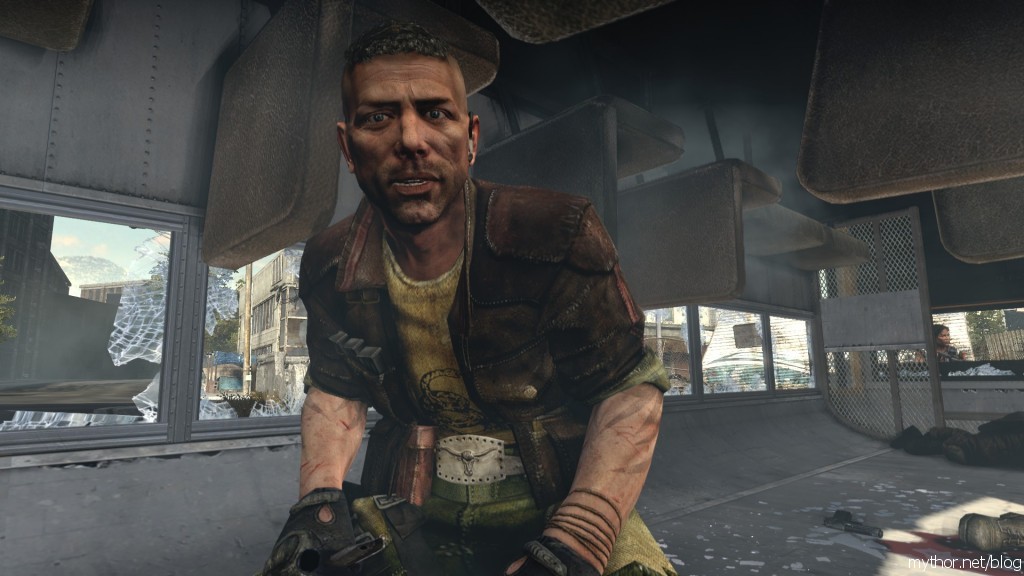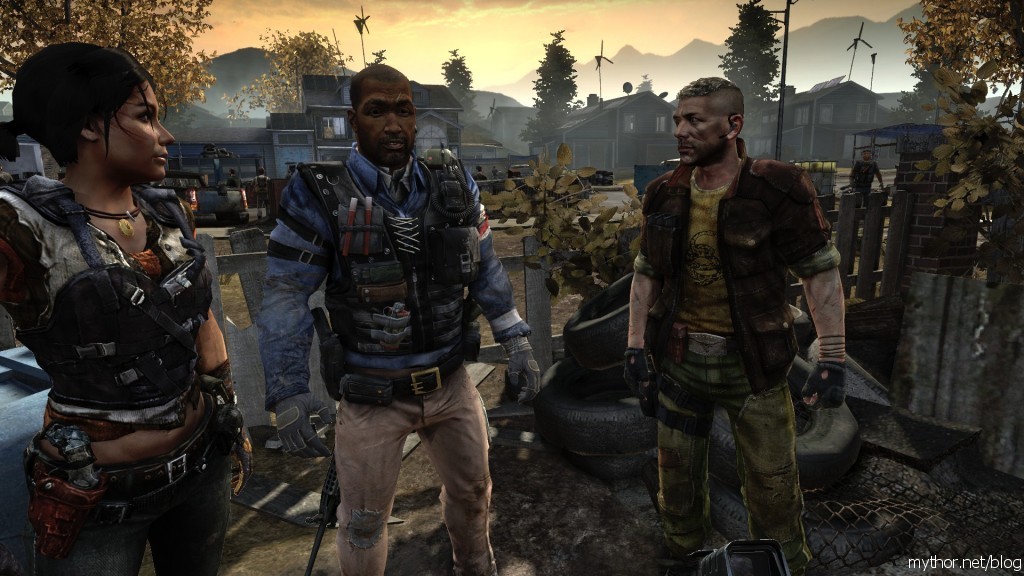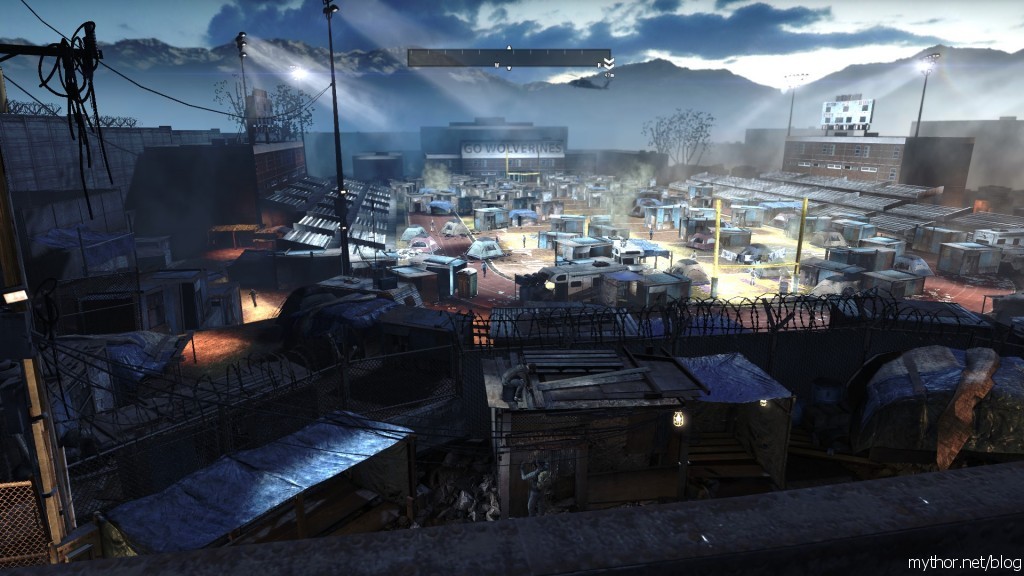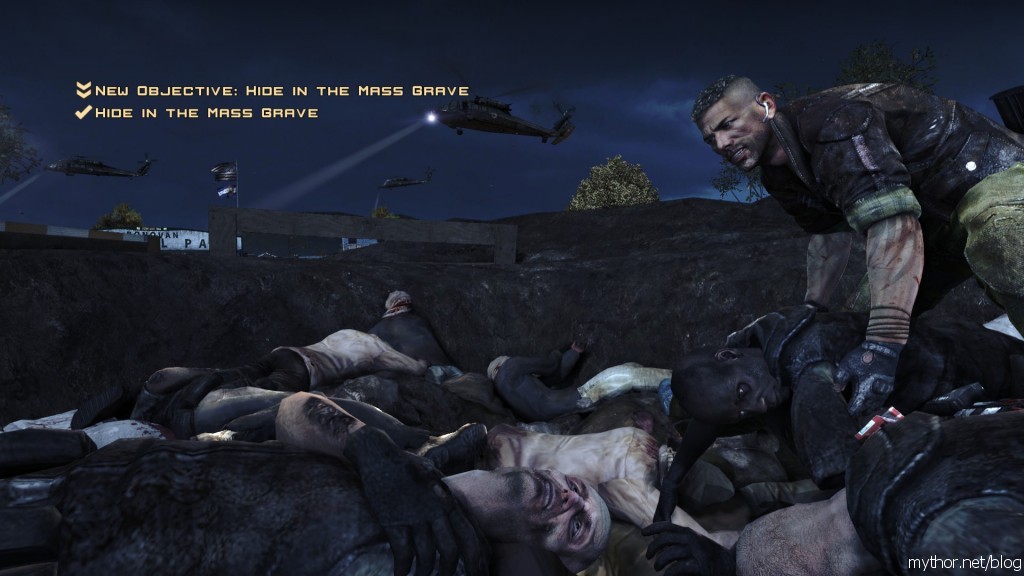Homefront is Kaos Studios’ second entry into the crowded FPS genre, their first being 2008’s Frontlines: Fuel of War. Both games are set in a possible near-future war, with Frontlines’ conflict based around the inevitable exhaustion of the world’s oil supplies and Homefront exploring the possibility of an aggressively expanding North Korea.
Homefront’s singleplayer campaign takes place as the western half of America has been occupied for a few years by an army from North Korea. The living conditions for the average American are pretty grim. Either they eke out a living on their own among the shattered remnants of their cities, or more likely they are conscripted into forced labour crews, toiling endlessly for the occupying forces.
As the game gets underway this seems to be the fate that has found you. You’ve been rounded up by the Korean People’s Army – the KPA or “norks” – along with some other poor unfortunates and shepherded onto a converted school bus. It emerges that this group consists of people with some level of flight experience, with the assumption you’re to be put to work. After some “re-education”, of course.
As the bus winds through the streets of a shattered American town you look out to see KPA troops harassing civilians, arresting them in some instances, beating them with boots and rifle butts in others. As one runs away from the troops he is, quite casually, shot in the back of the head, leaving a wet splatter of blood on the window ahead of you.
If that’s a little too grim for you, this is the point you should stop playing. Because the game goes to much darker places than this before the end.
As you might reasonably expect from the setting you are fairly quickly conscripted by the local militia in their efforts to fight back against the occupying army. If you wanted to fight this war on the Korean side you’re out of luck.

If you’ve played other recent FPS titles set in the modern era you’ll have a fair idea of what is expected of you in Homefront. Someone who is physically with you or in radio contact will tell you what needs doing or who needs killing and you’re expected to follow those instructions, with varying degrees of punctuality being required.
Simple “move here” objectives will often have no time limit attached, giving you time to explore your immediate vicinity for collectable newspapers that fill in the backstory of the game.
At other times a “move here” objective, like moving to and boarding a truck, must be acted upon within seconds or you will fail and have to retry from the last checkpoint.
Fortunately those checkpoints are frequent and conveniently placed.

Death often comes quite unexpectedly in Homefront, too, forcing more checkpoint restarts. The game features the now-ubiquitous on-screen warning indicator for grenades, letting you know that an enemy has lobbed an explosive ball of death in your general vicinity. This gives you time to find cover or otherwise move outside the blast radius.
At least, that’s the theory. Unfortunately the AI in Homefront is unnervingly accurate with its grenade tosses, often leaving you with little to no time to get safely away. And then there’s the inexplicably inconsistent damage the grenades inflict, should you be unfortunate enough not to make it clear of the blast. Sometimes you can stand virtually on top of a grenade and not suffer a fatal amount of damage yet at other times you can be uninjured and almost outside the blast radius and be instantly killed.

If you decide to try flanking an enemy in certain sections of the game you will find it’s a very useful tactic. Try it again two minutes later and you get shot in the head by a sniper, forcing another trip back to the previous checkpoint.
Occasionally you’ll be called to paint a target with a laser to set up a precision strike. Often this is a simple task you can do from some nearby cover. Sometimes you will need to run out into the middle of a firefight to make it happen as weird sightline issues prevent you from getting a lock on your target. Expect to die a few times due to that little gem.
All this dying might give the impression that the game is unrelentingly difficult, but the reality is far simpler – Homefront’s singleplayer campaign is very brief.
Even a casual FPS gamer should not have any trouble getting through the entire story in under 5 hours on the default difficulty. More experienced gamers should expect it to last around 3 hours from start to finish.
All the unfair deaths and failure situations seem designed solely to disguise the unprecedented shortness of the campaign. Even the Call of Duty series, long criticised for the brevity of the singleplayer experience, wisely stick to average play times above the 5 hour mark.
What Homefront lacks in longevity it more than makes up for in clever pacing and tightly woven action.
You’re never asked to eliminate some air defences for some fighter jocks you’ll never meet to blow up something you’ll never see. If you need to blow up a SAM site it’s so you can safely escape in the helicopter you’re planning to hijack. You don’t sit in a belltower with a sniper rifle picking off hapless minions because they’re there, you’re picking off specific targets for your friends to sneak through enemy lines.
None of the objectives ever feel like they’re just padding. You’re not facing off against wave after wave of enemies for a specific length of time. If you’re tasked with defending someone or something it’s more likely to be for twenty to thirty seconds rather than two to three minutes of firing a minigun into the hapless hordes of cannon fodder.
Other than being extraordinarily brief and tightly tied together, the Homefront singleplayer experience is much the same as other recent FPS titles. There’s the requisite “stealthy” section, a part where you have to fly an aircraft, a bit where you get to use a sniper rifle and a bunch of moving from cover to cover, gunning down whoever gets in the way.
Enemy AI ranges from competent to a little too good, ensuring you’re rarely in situations where you can simply abuse the AI’s shortcomings to succeed.

The singleplayer does have one issue that is likely to frustrate most everyone at some point. In certain missions you’re told to follow your companions to the next waypoint. If you’re a good little rebel soldier and follow right on their heels you will often get to the waypoint at almost the same time as your companions.
Your companions will then stand there staring blankly at you while you try and discover what you’re supposed to do next. It seems the “Continue” trigger is set a bit before the waypoint location and if you cross it before the NPCs are ready for you, nothing will happen. You’ll need to run back a short distance and re-approach them to get things moving again.
Not gamebreaking but it does happen often enough that you begin to wonder what the game’s testers were doing.
But where Kaos Studios and THQ are obviously hoping to hit the jackpot is in the multiplayer portion of the game.
Homefront’s multiplayer offering includes the regulation Team Deathmatch and what they’re calling Ground Control, which is very similar to Frontlines’ standard multiplayer mode.
In Ground Control there are three locations on the map that your team has to capture and hold. Locations are captured automatically when a player is within about 15 metres of the goal. The more allies capturing a point at once, the faster the process goes. If even a single enemy player gets within capture range it becomes a contested – unable to be captured – point until one side or the other no longer has anyone in range.
Each location a team controls fills a victory meter just above the minimap. Once a team’s meter is completely filled they are awarded a point and the game shifts the capture locations to another area.
The first team to get to two victory points wins the match.
That’s all fairly straightforward and probably familiar to many.
Where Homefront differentiates itself is in the addition of a Battle Commander, which can be enabled for either Team Deathmatch or Ground Control.
The Battle Commander is an AI that is not allied with either team. Instead it sits on the sidelines rewarding players who are doing well – with extra armour, health, a personal motion sensor and other goodies – while simultaneously putting prices on the heads of those players who’re racking up the points. If you kill 3 people in a row without dying yourself you might be rewarded with a flak jacket… and find yourself under the gun from two enemy players who’re alerted to your success and given a marker displaying your general location.
So if you’re slaughtering the opposition from the comfort of your attack helicopter then you’re not only going to have to deal with people who’re annoyed at being killed by you but also their team mates hunting you for the big Battle Point bounty on your head.
Battle Points are the in-game currency of the game, another area where Homefront is setting itself apart from the competition. In other games if you want an RPG to fire at a tank you would have to swap to a kit loadout that includes an RPG.
In Homefront you can spend some of your accrued Battle Points and instantly buy an RPG. Or instantly purchase a flak jacket, or a recon drone, or an attack drone, or call in a Hellfire strike.
Or, when respawning, you could choose to spend your points on a Humvee, tank or helicopter of your very own. There’s no fighting over who gets to drive or fly in Homefront as when you purchase a vehicle you’re automatically in the driver’s seat. Team mates can then choose to spawn into the secondary seat on your vehicle, taking control of a secondary turret.
Battle Points reset between maps so everyone is much more likely to spend them on an RPG if it’s needed or a drone to harass the enemy. And you’re never left behind the curve by higher level players constantly respawning in tanks while you can’t even afford a recon drone. Everyone starts with the same number of Battle Points and earns them according to their performance.
In between rounds there’s a decent amount of customisation on offer for your soldier’s kit. You can choose your primary weapon from among a handful of assault rifles, machine guns and sniper rifles. Many of the guns feature an assortment of optional attachments like optical sights, silencers, underbarrel shotguns or grenade launchers and all of the guns are able to be painted with various camouflage patterns.
The attachments are unlocked by reaching certain milestones in your kill count with the weapon in question. So your M4 Rifle will start out as a standard rifle with regular sights until you’ve achieved 5 kills with it. At that point you unlock some of the holographic scopes and can attach one to your rifle, vastly improving your ability to hit targets at longer ranges.
And you’ll want to be hitting things at longer ranges when you can. Infantry in Homefront are extremely fragile. One or two bursts from most of the automatic weapons is enough to put people down and two body shots from a sniper rifle – or one headshot – is also enough to kill someone.
Like most other modern shooters you do have regenerating health, however with so few bullets being required to put you out of the fight it’s rare you’re given the opportunity to seek cover after being shot.
While both the KPA and USA teams have identical kit, in practice the differences in style between players and teams matter more than having the extra variety of side specific weaponry.
It’s a little harder to excuse the paucity of primary weapons on offer. Six assault rifles, two light machine guns, two sub machine guns and two sniper rifles. Though until you advance in levels you won’t even have half so many options.
The “Perks” system from the Call of Duty series also makes an appearance in your soldier’s customisation screen. There’s the expected faster reload speed, better melee knife and some drone boosting perks for those who use them.
Kaos have also extended the perks system to the vehicles, letting you choose a larger gas tank, faster turret turn speeds, more armour and so on. You don’t get to tinker with most of these until you’ve been playing multiplayer for quite a while but it’s another twiddly knob you can tweak to suit your own personal tastes.
But all the twiddly knobs can’t save the multiplayer side of the game from some really basic shortcomings, particularly compared to the competition.
Everyone knows it’s a tedious job testing a map to find every last spot where players can get stuck or can’t traverse as they would expect. But the number of tiny steps a player cannot walk over, or invisible blocks in the terrain, is quite unacceptable. Particularly when some of those invisible blocks in the terrain prevent bullets reaching their target… or cause rockets to explode in one’s face, despite an apparently unimpeded path.
Speaking of bullets not reaching their targets, between now and 2025 someone is going to invent bulletproof white picket fences. And bulletproof gyprock. And bulletproof tarps used as makeshift windows. And bulletproof chainlink fences…
There is zero bullet or explosive penetration in Homefront. Shrubs and tall grass are about the only things that don’t offer protection from bullets. Doesn’t matter what gun you’re firing at a piece of sheet metal with, your enemy is completely safe behind it. Even a tank shell won’t do anything beyond rattle their teeth a little.
Five years ago this would have been expected and unremarkable. Since then we’ve had the Call of Duty series introduce the concept and the Battlefield series take it a step further, allowing the destruction of buildings that would previously have been impregnable fortresses.
For Homefront to so completely ignore this is a shame.
The most disappointing part of Homefront’s multiplayer is not entirely Kaos’ fault, however. 95% of the dedicated servers currently online for the PC version of the game aren’t running with the Battle Commander enabled. One of the major areas in which Homefront is doing something different to everyone else and most people playing the game aren’t even seeing it. While this is down to the various server providers not switching the option on, Kaos has to take some responsibility for not pushing it harder.
These problems are not unfixable though. With some extra work by Kaos and some pointed nudging by the community to their preferred server providers, Homefront could be a solid third entrant in the field.
As it stands the game is difficult to recommend at the $70-80 THQ is asking in Australia. The singleplayer portion of the game is simply too short, despite being enjoyable while it lasts. The multiplayer is fun for a few hours but lacking in longevity with a small array of maps. With most of the servers not utilising the Battle Commander system there’s little to recommend it over the technically superior Battlefield: Bad Company 2 or the much more popular Call of Duty: Black Ops.
With some prompt attention from the developers Homefront has potential. If they allow the problems to linger too long, as they did with Frontlines: Fuel of War, the game is destined for the scrap heap like so many pretenders before it.
Score: 67%
